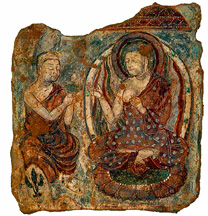
Kumtura, "Cave at the River Bend" (Cave 43?) near Kizil
Xinjiang Province, China
8th century CE
Mural, ink and mineral pigments
47 x 42 cm
Acquisition number: #MIK III 9024
Image courtesy of the Museum für Indische Kunst (copyright reserved)
Staatliche Museen zu Berlin - Preussischer Kulturbesitz
We do not know for certain from which cave this mural was removed, other than a description that the cave was located near the bend of a river. Some specialists believe it may have been removed from a cave in the area known as Cave 43, partly due to its location near to a river, but also due stylistic similarities the mural shares with the paintings that remain in this cave. From the layout of the ceiling paintings still extant in the cave, it is clear that the original plan divided the vaulted ceiling into separate rectangular-shaped murals. The subjects of the surviving murals are all scenes of the Buddha lecturing, with some of them also featuring the white spot pattern seen on the robe of the Buddha reproduced here. The murals were separated by a series of lines resembling stylized mountains, each decorated with a single plant or miniaturized tree, resembling those located in the lower right corner of this painting.1
Caves in the Kizil region tend to demonstrate strong influences from the Indian, Sassanian and Chinese painting traditions. Yet surprisingly, these styles tend to remain isolated from each other, with little stylistic intermingling found in a single cave site. This may indicate a division of work along ethnic lines among the various workshops supplying artists to decorate the caves, with each group specializing in a different regional style. This mural is an exception, being something of an amalgamation of all three of these stylistic sources.2
(1) Doitsu Torufan tankengumi: Sai'iki bijutsuten (Tokyo: Tokyo National Museum, 1991), p. 120.